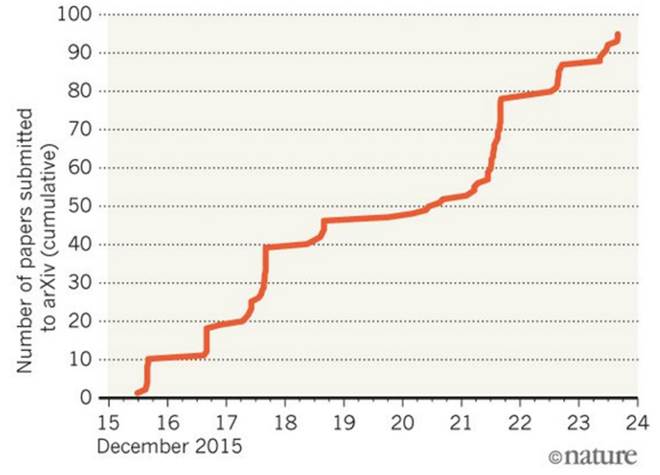Even more annoying to some is the fact that the press picked up and overhyped the news, as is quite common in similar circumstances. I personally do not mind, as I belong to the minority who considers this in general a good thing in almost all cases, as it gives some visibility to particle physics and a chance to make our science more understandable to the general public, whatever the claim that is made and however true or fake it is. However, at some point we need to clean up the mess and sweep the floor of all the useless paper clips. We will have to wait for 2016 data to do that, unfortunately, as there is no way to convince the enthusiasts that this is no different from all the other spurious signals that ATLAS and CMS have seen in the past.
Maybe what I can do here is to just remind you of one similar anomaly that got people very excited but went away in 2015 data. That is of course the diboson bump that was seen by ATLAS and CMS at 1.8-2 TeV. It was an over-3-sigma observation by ATLAS, and a 2-sigmaish thing in CMS. The experiments cannot see anything similar in their higher-energy data - granted, the studied luminosity is only a fifth of the 2012 one, but the energy is over 60% higher so any massive object should show up more frequently now, as shown by the graph below.
What is shown is the enhancement in production rate of a massive object as one goes from 8 to 13 TeV in the center of mass. The different curves refer to the different production mechanisms, i.e. whether the thing is produced by gluons or quarks.
So, the enhancement factor for a 2 TeV object should make up for the smaller dataset; as nothing is seen in the new data, the hope that the 2 TEV thing is real has dimmed quite considerably. Nowadays nobody is excited by it any more, as everybody is more interested in the new kid in town, of course. Watch how theorists around the world have left every other thing they were working on hanging, to concentrate on providing an interpretation of the 750 GeV fluctuation: the graph is from Nature.

The new particle can be almost anything. You name it, we have a mechanism for it. Here is a short list of what it can be: Two higgs doublets, Seesaw vectorlike fermions, Closed strings, Neutrino-catalyzed, Indirect signature of DM, Colorful resonances, Resonant sneutrino, SU(5) GUT, Inert scalar multiplet, Trinification, Dark left-right model, Vector leptoquarks, D3-brane, Deflected-anomaly SUSY breaking, Radion candidate, Squarkonium-Diquarkonium, R-parity violating SUSY, Gravitons in multi-warped scenario. And the list continues to thicken on a daily basis.
Once one skims the 100+ papers produced in the past two weeks, one understands that it is simpler to list what the thing cannot be. Here is my interpretation:
 1) It cannot be the Lochness monster. As shown below, the well-known beast has a characteristic three-bump structure which is not replicated by the experimental data.
1) It cannot be the Lochness monster. As shown below, the well-known beast has a characteristic three-bump structure which is not replicated by the experimental data. 2) It cannot be Mickey Mouse either, as Mickey has a clear non-Gaussian tail which experiments have not even tried to fit, due to numerical approximations of the discontinuity.
2) It cannot be Mickey Mouse either, as Mickey has a clear non-Gaussian tail which experiments have not even tried to fit, due to numerical approximations of the discontinuity.I do not blame the theorists - after all, it is their Christmas they decided to spoil. But I am rather appalled by observing that Twitter polls show that 65% of the participants believe the diphoton bump is a real new particle. I wish people knew better. Do you ?




Comments